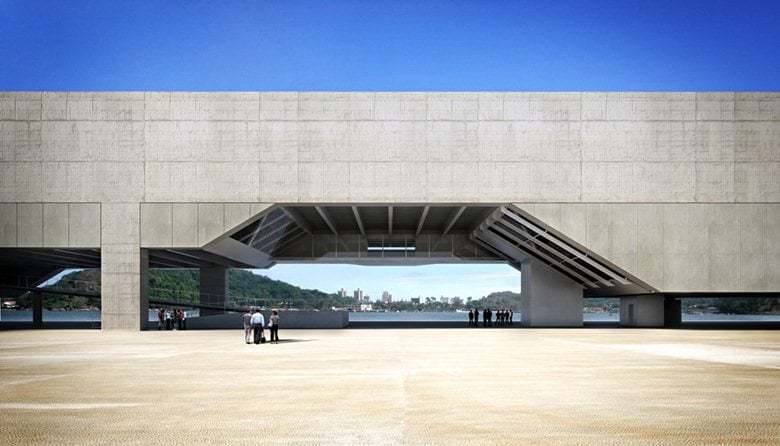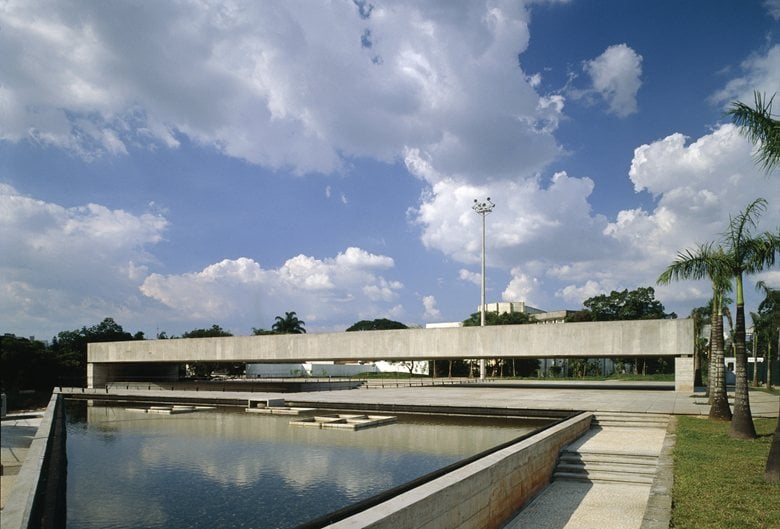Paulo Mendes da Rocha
Architect São Paulo / Brazil
 213
213
 30 2
30 2
Cais das Artes
Gualeguaychú / Brazil / 2010
 16
16
MAM SANTOS
Santos / Brazil / 2010
 4
4
Museu-escola
Santo André / Brazil / 2007
 5
5
Patriach Plaza
São Paulo / Brazil / 2002
 2
2
FIESP Centro Cultural
São Paulo / Brazil / 1997
 5
5
Pinacoteca do Estado de São Paulo
São Paulo / Brazil / 1993
 7
7
MuBE | Museu Brasileiro de Escultura
São Paulo / Brazil / 1988
 11 1
11 1
Galeria Leme
São Paulo / Brazil
Soon after his graduation, in 1957 he won a national competition for the construction of a gymnasium – the Clube Atlético Paulistano. This work brought him public recognition and won the principal award at the 6th Bienal of São Paulo, in 1961 – Grande Prêmio Presidência da República. In 1968, he won the national project competition for the Brazilian Pavilion at Osaka Expo 70 and travelled to follow the development of the construction in 1969.
Among several international honors, he has been awarded with the Mies Van der Rohe Foundation Prize for his Pinacoteca de São Paulo project. He was selected in 2000 to represent Brazil at the 7th International Architecture Exhibition of La Biennale di Venezia. He received the Pritzker Architecture Prize in 2006.
In Brazil, he was twice honored with the Ordem do Mérito Cultural, in 2004 and 2013. He also received twice the trophy from APCA “Associação Paulista de Críticos de Arte”, in 2012 and 2015.
In 2016, he was awarded with the Golden Lion for lifetime achievement at Venice Architecture Biennale and with the Imperiale Praemium in honour of Prince Takamatsu in the category of architecture in Japan.
He joined the academic world in the sixties when invited to teach at the School of Architecture and Urbanism at the University of São Paulo. He taught at the University of São Paulo from 1960 to 1969 and from 1980 till 1998; in 2010 he received the title of Professor Emeritus. He was President of the Brazilian Institute of Architects, São Paulo in 1972/1973 and 1986/1987.
Besides his architectural and urban projects, he has designed furniture: one example is the chair ‘Paulistano’, published in the magazine New Furniture, Neue Möbel, Meubles Nouveaux, Verlag Gerd Hatje, Stuttgart, 1958.
He has accepted several invitations from international universities:
2001 Professor ad Honorem of the Facultad de Arquitectura, Universidad de la República del Uruguay
2007 Doctor Honoris Causa, Universidade Presbeteriana Mackenzie, São Paulo
2009 Doctor Honoris Causa, Universidad Nacional del Litoral, Santa Fe, Argentina
2010 Professor Emeritus, Faculdade de Arquitetura e Urbanismo da Universidade de São Paulo, USP
2011 Doctor Honoris Causa, University of Architecture and Urbanism "Ion Mincu", Bucharest, Romania
2012 Doctor Honoris Causa for distinction in the arts, science, culture, human rights, Universidad Nacional de Córdoba, Argentina
2015 Doctor Honoris Causa, University of Lisbon.
Mendes da Rocha’s complete work is widely published:
Mendes da Rocha, Introducciones / Introductions, Josep Ma.Montaner, Editorial Gustavo Gili, Barcelona, 1996;
Paulo Mendes da Rocha, Cosak & Naify, 2000 and 2007;
Paulo Mendes da Rocha Bauten und Projekte, Annette Spiro, Verlag Niggli AG, Sulgen I Zürich, 2002; Paulo Mendes da Rocha, Helio Piñon, Romano Guerra Editora, 1ª edição 2002;
Paulo Mendes da Rocha Estrutura: o êxito da forma, Denise Chini Solot;
Paulo Mendes da Rocha – Fifty Years, Rizzoli, 2007;
Paulo Mendes da Rocha – Tutte le Opere, Daniele Pisani, con un saggio di Francesco Dal Co, Mondadori Electa S.p.A., Milano, 2013.
The 2017 Royal Gold Medal medallist was nominated and seconded by architects Neil Gillespie OBE and John McAslan CBE; their comments follow. Paulo Mendes Da Rocha’s nomination was supported by architects Sir David Chipperfield CBE, John Tuomey and Yvonne Farrell.

Paulo Mendes da Rocha was born in October 1928 in the city of Vitória- the harbor capital of Espírito Santo, son of the naval engineer Paulo Menezes Mendes da Rocha and Angelina Derenzi, daughter of an Italian family that had emigrated to Brazil. When his father assumed the coordination of the Naval and Harbor discipline at the Polytechnic School of the São Paulo University (USP) in 1940, the family moved to São Paulo. Paulo Mendes da Rocha graduated from the Mackenzie University Architecture School in 1954 and built a career planning houses, schools, apartment buildings, museums, several urban projects, stations and sport equipment, furniture and theatre sets. Soon after his graduation, in 1957 he won a national competition for the construction of a gymnasium – the Clube Atlético Paulistano. This work brought him public recognition and won the principal award at the 6th Bienal of São Paulo, in 1961 – Grande Prêmio Presidência da República. In 1968, he won the national project competition for the Brazilian Pavilion at Osaka Expo 70 and travelled to follow the development of the construction in 1969. Among several international honors, he has been awarded with the Mies Van der Rohe Foundation Prize for his Pinacoteca de São Paulo project. He was selected in 2000 to represent Brazil at the 7th International Architecture Exhibition of La Biennale di Venezia. He received the Pritzker Architecture Prize in 2006. In Brazil, he was twice honored with the Ordem do Mérito Cultural, in 2004 and 2013. He also received twice the trophy from APCA “Associação Paulista de Críticos de Arte”, in 2012 and 2015. In 2016, he was awarded with the Golden Lion for lifetime achievement at Venice Architecture Biennale and with the Imperiale Praemium in honour of Prince Takamatsu in the category of architecture in Japan. He joined the academic world in the sixties when invited to teach at the School of Architecture and Urbanism at the University of São Paulo. He taught at the University of São Paulo from 1960 to 1969 and from 1980 till 1998; in 2010 he received the title of Professor Emeritus. He was President of the Brazilian Institute of Architects, São Paulo in 1972/1973 and 1986/1987. Besides his architectural and urban projects, he has designed furniture: one example is the chair ‘Paulistano’, published in the magazine New Furniture, Neue Möbel, Meubles Nouveaux, Verlag Gerd Hatje, Stuttgart, 1958. He has accepted several invitations from international universities: 2001 Professor ad Honorem of the Facultad de Arquitectura, Universidad de la República del Uruguay 2007 Doctor Honoris Causa, Universidade Presbeteriana Mackenzie, São Paulo 2009 Doctor Honoris Causa, Universidad Nacional del Litoral, Santa Fe, Argentina 2010 Professor Emeritus, Faculdade de Arquitetura e Urbanismo da Universidade de São Paulo, USP 2011 Doctor Honoris Causa, University of Architecture and Urbanism "Ion Mincu", Bucharest, Romania 2012 Doctor Honoris Causa for distinction in the arts, science, culture, human rights, Universidad Nacional de Córdoba, Argentina 2015 Doctor Honoris Causa, University of Lisbon. Mendes da Rocha’s complete work is widely published: Mendes da Rocha, Introducciones / Introductions, Josep Ma.Montaner, Editorial Gustavo Gili, Barcelona, 1996; Paulo Mendes da Rocha, Cosak & Naify, 2000 and 2007; Paulo Mendes da Rocha Bauten und Projekte, Annette Spiro, Verlag Niggli AG, Sulgen I Zürich, 2002; Paulo Mendes da Rocha, Helio Piñon, Romano Guerra Editora, 1ª edição 2002; Paulo Mendes da Rocha Estrutura: o êxito da forma, Denise Chini Solot; Paulo Mendes da Rocha – Fifty Years, Rizzoli, 2007; Paulo Mendes da Rocha – Tutte le Opere, Daniele Pisani, con un saggio di Francesco Dal Co, Mondadori Electa S.p.A., Milano, 2013. The 2017 Royal Gold Medal medallist was nominated and seconded by architects Neil Gillespie OBE and John McAslan CBE; their comments follow. Paulo Mendes Da Rocha’s nomination was supported by architects Sir David Chipperfield CBE, John Tuomey and Yvonne Farrell.
